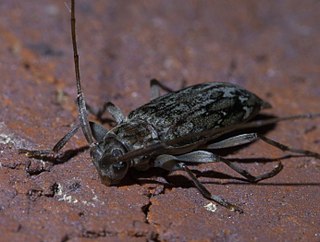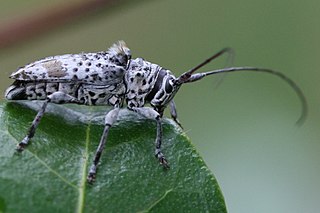
Dorcasominae is a subfamily in the longhorn beetle family Cerambycidae. There are about 14 genera and more than 30 described species in Dorcasominae, found mainly in Asia and Africa. These genera are sometimes considered members of the tribe Dorcasomini, which would be the only tribe of this subfamily. This classification is in accordance with the TITAN Cerambycidae database, Catalogue of Life, and Photographic Catalog of the Cerambycidae of the Old World. It is similar to that of Bouchard et al. in "Family-group names in Coleoptera", 2011.

Lepturges is a genus of longhorn beetles of the subfamily Lamiinae. It was described by Henry Walter Bates in 1863.
Icariotis is a genus of Long-Horned Beetles in the beetle family Cerambycidae. There are about 15 described species in Icariotis, found in Madagascar.

Desmiphorini is a tribe of longhorn beetles of the subfamily Lamiinae.
Athylia is a genus of beetles in the family Cerambycidae, containing the following species:
Atimura is a genus of beetles in the family Cerambycidae, containing the following species:
Isse is a genus in the longhorn beetle family Cerambycidae. This genus has a single species, Isse punctata, found in South Africa.

Crossotini is a tribe of longhorn beetles of the subfamily Lamiinae. It was described by Thomson in 1864.

Corus is a genus of long-horned beetles in the family Cerambycidae. There are more than 30 described species in Corus.
Ancita is a genus of longhorn beetles of the subfamily Lamiinae, containing the following species:

Pharsalia is a genus of long-horned beetles in the family Cerambycidae. There are at least 40 described species in Pharsalia, found mainly in South and Southeast Asia.>

Clyzomedus is a genus of flat-faced longhorns in the beetle family Cerambycidae. There are about 10 described species in Clyzomedus.
Anaches is a genus of longhorn beetles of the subfamily Lamiinae. The genus is distributed in South, Southeast, and East Asia, from India and Nepal eastward to China and Taiwan.

Rhytiphora is a genus of flat-faced longhorn beetles in the Pteropliini tribe of the subfamily Lamiinae. The genus was first described in 1835 by Jean Guillaume Audinet-Serville.

Disterna is a genus of longhorn beetles of the subfamily Lamiinae.

Chaetosoma is a genus of beetles in the family Chaetosomatidae. There are at least two described species in Chaetosoma, found in New Zealand.
Apodasya pilosa is a species of beetle in the family Cerambycidae, described by Chevrolat in 1843. The species was renamed by Pascoe in 1863 when he replaced the genus name, but Pascoe's usage has been declared a junior subjective synonym under the ICZN, and the authority remains with Chevrolat.

Coptocercus is a genus of beetles in the family Cerambycidae, mainly found in Eucalypts.

Coptocercus crucigerus is a species of beetle in the family Cerambycidae, first described by Frederick William Hope in 1842 as Stenochorus cruciger, from a specimen collected in Port Essington (Darwin). In 1929, Herbert James Carter assigned the species to the genus Coptocercus, and also synonymised it with Phoracantha politaPascoe, 1863.
Pentacosmia is a genus of longhorn beetles in the subfamily Lamiinae. It is endemic to Australia.











